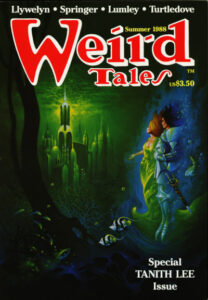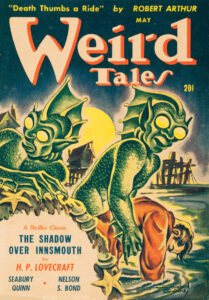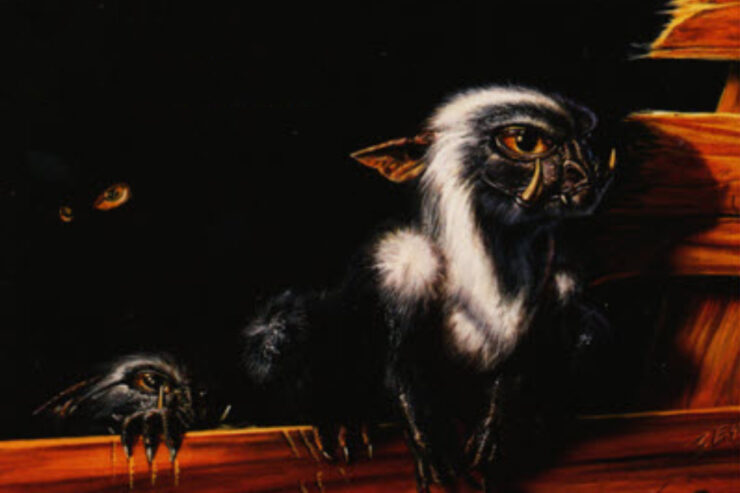 The brainchild of Jacob C. Henneberger, co-publisher of College Humor, Weird Tales was the first periodical devoted to fantasy and the supernatural. The magazine also provided a home for early science fiction. Edited by Edwin Baird, its first issue was dated March 1923.
The brainchild of Jacob C. Henneberger, co-publisher of College Humor, Weird Tales was the first periodical devoted to fantasy and the supernatural. The magazine also provided a home for early science fiction. Edited by Edwin Baird, its first issue was dated March 1923.
Convinced that a magazine dedicated to the strange and unusual could be successful, Henneberger sold his interest in College Humor and the company’s other magazines and plowed his proceeds back into Weird Tales, naming Farnsworth Wright his editor.
Although H. P. Lovecraft sometimes found him to be “a most bewilderingly capricious cuss!” it was Farnsworth Wright’s sense of the commercial pulp fiction market that kept the magazine afloat through some very challenging times.
Weird Tales never quite reached the heights that Henneberger had imagined for it. However, it published some of the best fantasy and supernatural fiction of the twentieth century. Eventually sold to William J. Delaney, publisher of Short Stories, “The Unique Magazine” managed to last until its September 1954 number, a total of 279 issues.
Nearly twenty years after its demise, Weird Tales became “The Magazine That Never Dies.” During 1973 – 74, Weird Tales was revived for four issues, edited by Sam Moskowitz. A paperback series lasting four more issues — edited by Lin Carter — appeared from 1981 to 1983. During 1984 – 85, Brian Forbes published two issues of what has become known as the California Weird Tales. The magazine was revived again in 1988 by George H. Scithers, Darrell Schweitzer, and John Gregory Betancourt. Since then, it has, more or less, been published continuously. The 366th issue was released earlier this year, marking the magazine’s 100th anniversary.
We hope you’ll join PulpFest 2023 on Friday, August 4, at 9:45 pm for “Weird Editors,” a look at the Terminus Publishing, DNA, and early Wildside Press years of the magazine. Joining moderator Tony Davis will be the two surviving editors of those years, Darrell Schweitzer and John Betancourt.
 A mystery, fantasy, and science fiction writer, John Betancourt is also the publisher of Wildside Press. As such, he has made hundreds of stories from pulp magazines, digests, and early paperbacks available in print and ebook form. Formerly an assistant editor at Amazing Stories, John later helped to revive Weird Tales. The magazine garnered a World Fantasy Award in 1992 and a Hugo Award in 2009. In 2015, he also helped revive Weirdbook. He continues to publish it on a fairly regular basis. John also serves as the publisher of Sherlock Holmes Mystery Magazine and the revived Startling Stories, the classic science fiction pulp.
A mystery, fantasy, and science fiction writer, John Betancourt is also the publisher of Wildside Press. As such, he has made hundreds of stories from pulp magazines, digests, and early paperbacks available in print and ebook form. Formerly an assistant editor at Amazing Stories, John later helped to revive Weird Tales. The magazine garnered a World Fantasy Award in 1992 and a Hugo Award in 2009. In 2015, he also helped revive Weirdbook. He continues to publish it on a fairly regular basis. John also serves as the publisher of Sherlock Holmes Mystery Magazine and the revived Startling Stories, the classic science fiction pulp.
Darrell Schweitzer’s distinguished editorial career began with Isaac Asimov’s SF magazine (1977-1982), Amazing Stories (1982-1986), Weird Tales (1987-1994), Worlds of Fantasy and Horror (1994-1996), before returning to Weird Tales (1998-2007). The author of numerous science fiction and fantasy novels and short fiction, Darrell is also a notable authority on Lord Dunsany, H. P. Lovecraft, and Robert E. Howard. Twice nominated for a World Fantasy Award, he was the recipient of the 1992 Award for his successful revival of Weird Tales. Darrell has been selling at PulpFest for the last three years and has been a regular contributor to The Pulpster for some time.
A resident of Ontario, Tony Davis edited the first 21 issues of The Pulpster and continues to be a regular contributor to the magazine. He won the Lamont Award in 1999 for his many contributions to the pulp community. Recently, Tony revived the Fantastic Pulps Show & Sale — Canada’s premier pulp event — at the Lillian H. Smith Branch of the Toronto Public Library in Ontario.
A longtime collector of Weird Tales and other pulp magazines, Tony is particularly interested in the rare Canadian version of “The Unique Magazine.” Published during World War II due to import restrictions, the Canadian editions were sometimes different from the U.S. editions.
The general public is welcome to attend our evening programming events free of charge. To learn more about our programming, please click the Schedule button at the top of this page.
For those who also want to enjoy our dealers’ room, you can join PulpFest by clicking the Registration button at the top of this page. And don’t forget to book a room at the DoubleTree. They’re going fast!
 Our featured image was excerpted from Bob Eggleton’s cover art for Weird Tales for Fall 1991, a special William F. Nolan issue of the long-running magazine. Nolan was the guest of honor at PulpFest 2010.
Our featured image was excerpted from Bob Eggleton’s cover art for Weird Tales for Fall 1991, a special William F. Nolan issue of the long-running magazine. Nolan was the guest of honor at PulpFest 2010.
Born in 1960, Bob Eggleton has won the Hugo Award nine times as “Best Pro Artist” in science fiction and fantasy, first winning in 1994.
Our lead image was adapted by PulpFest advertising director William Lampkin from Frank Kelly Freas’ cover art for the Fall 1990 issue of Weird Tales.
Freas actually contributed a similar cover to Weird Tales when he was an art student in 1950. His painting was accepted by then-Weird Tales editor Dorothy McIlwraith with one condition. According to Ralph E. Vaughan’s Book Scribbles blog, McIlwraith asked the artist to “surround the figure with a nimbus of moondust, which helped to highlight its form, separating it from the background.” According to Vaughan, Kelly Freas “liked the result so much he used the technique in various paintings and drawings the rest of his life.”
The Summer 1988 number of Weird Tales was the second issue of the Terminus Publishing version of the magazine. It featured cover art by Stephen E. Fabian.
Due to import restrictions during the Second World War, a Canadian edition of Weird Tales was issued, starting in 1942. The magazine didn’t always share the same content as US editions, using fiction from Short Stories and a variety of issues of the US Weird Tales. During a brief period, the Canadian editions also featured cover art variants.
Edmond Good contributed the front cover art for the May 1942 Canadian Weird Tales. During the early years of World War II, Good was hired as art director of Bell Publishing where he also contributed to their lines of comic books. Around this time, he began to paint covers for pulp magazines, including the Canadian Weird Tales and Thrilling Detective. In 1943, he moved to the United States to work on “Scorchy Smith.” He later worked for DC Comics, Fawcett, and other publishers through the middle fifties when he turned to commercial art and scriptwriting for radio and television.
For more on Weird Tales, please visit our YouTube Channel to view our video Weird Tales Celebrates 100 Years, created by PulpFest‘s Craig McDonald. While you’re there, please be sure to subscribe to the PulpFest Channel.







